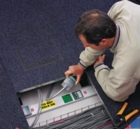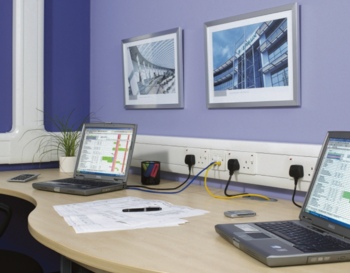Keeping up with the ’phoneses

Like the voices and data carried by communications networks, changes to technology in the sector move quickly. Staying on top of these changes is hugely important. Joanne Reynolds looks at some of the latest developments.
The UK’s ceaseless appetite for creating, transmitting and storing data means that the voice and data market is set to grow for the foreseeable future — and technology is following this demand by evolving and developing faster, better systems apace.
Power over Ethernet (PoE) is already being used in many applications. PoE provides power (usually DC) over twisted-pair cables and is normally used purely for voice, data and video. DC power is used for devices such as IP telephones, but the number of new applications for DC power is increasing rapidly.
Like any sector, voice and data cabling has its standards, and it is worth reminding ourselves what they are and what they mean. Choosing the right data cabling category is important because getting it wrong could mean making a business’s computer system obsolete in a matter of months or the client making an investment on which they will never really get a return.
Cables come in a number of different categories, defined largely by their performance in transmitting data. It is widely acknowledged that Cat 5e, where the e stands for enhanced, is cost effective, simple to install and supports applications including Gigabit Ethernet. If 10/100/1000 Ethernet is required, the 100 MHz bandwidth will be acceptable.
Cat 6 costs a little more. It also takes longer to install, but has greater bandwidth (200 MHz, tested to 250 MHz). However, this is not normally enough to support 10 Gigabit Ethernet (10GBase-T) beyond about 50 m.
Augmented Cat 6 is the UTP cabling platform being developed to support 10GBase-T, but its use must be considered as quite specialised, although it is only a matter of time and technology until it becomes the everyday norm.
At the top end is Cat 7, which is an expensive and complicated fully shielded system but it does boast a 600 MHz bandwidth. Not surprisingly only a small amount has been installed so far.
At present all the talk is about Cat 6. It typically costs only 10% more than Cat 5e to purchase but is considerably more difficult to install; with a well written specification it should attract a manufacturer-underwritten guarantee of 25 years. However, adopting a policy of consistently specifying Cat 6 can be difficult, especially in incremental installations where the density of existing Cat 5e outlets is being increased (perhaps owing to earlier under provisioning).
The history of Cat 3, 4, 5 and 5e, together with the increasing bandwidth requirements of applications, suggest that Cat 6 may be a better investment than Cat 5e for new-build installations. In its lifetime, the cabling will probably support several generations of equipment. The capital cost is higher, but the long-term cost of ownership may well be lower than Cat 5e.
It is worth mentioning again the main types of cable used in structured cabling installations: UTP; STP and fibre optic. Most computer networks are cabled using UTP (unshielded twisted pair) as it is a versatile product capable of supporting most system and network protocols.

STP (screened twisted pair) tends to be used in place of UTP in environments where there is high ambient noise or electromagnetic interference such as in a hospital. Fibre-optic cable is specified for high-speed, high bandwidth applications and is available in two formats — single-mode, widely used in telephony, and multi-mode, suitable for network communications. Multi-mode fibre is capable of handling large bandwidth, with high-speed data transmission.
2/3-compartment dado trunking is the accepted way of routing data and power around offices and buildings. It is segregated so that, usually, the power cable is contained within the central compartment, with data cable in the top and bottom — leaving the central compartment for easy installation of the accessories. This is an attractive solution that can meet the structured cabling requirements for Cat 5e and Cat 6. Cat 6e has still to be ratified but will have significant implications for cable management to the workstation when it has been.
Crucial, however, is careful management of data around corners, whether external or internal. The bend radius is critical in avoiding data corruption or loss. For the same reason, the bend radius at the data cable terminations to the data modules (located where required along the trunking) is also critical. Typically, the bend radius must not be less than four times the cable diameter after installation.
In terms of the invisible systems, screeded floor arrangements used to be very popular. Here, the various cables are laid in trunking set into the floor to pre-wired floorboxes. However, today this is considered to lack flexibility, especially when office layouts are constantly changing. In addition, modern office design tends to favour raised floors.
Raised-floor systems are a very popular option, being both flexible and versatile, with power running in track with tap-offs located at strategic positions. There are two ways of achieving power and data to the workstation. The first is via floorboxes directly. The second is to use a desk module (DeskPod). Here, cable exits the raised floor through a special ‘grommet’ and joins the desk via the module (fitted somewhere on the desk). Fused or unfused desk modules can be provided with clean earth, power/data points and, even, satellite communications.
For more complex installations where there is a high concentration of workstations it is prudent to use a ‘hub’ arrangement like Ackermann’s Spider unit. This comprises a galvanised housing, power unit (with MCB/RCBO protection) and data hub. Each hub can feed up to eight desks, through outlets fed by flexible tubes called ‘umbilicals’ leading to grommets. Power and data is fed to the underfloor ‘hub’ (rather like a sub-floor patch panel).
In terms of installation, there are many aspects to consider, but one essential one is the number of data points to be provided. Generally speaking, you should allow for a 20% over-capacity for a degree of future-proofing.
Joanne Reynolds is senior marketing communications manager with MK Electric.








